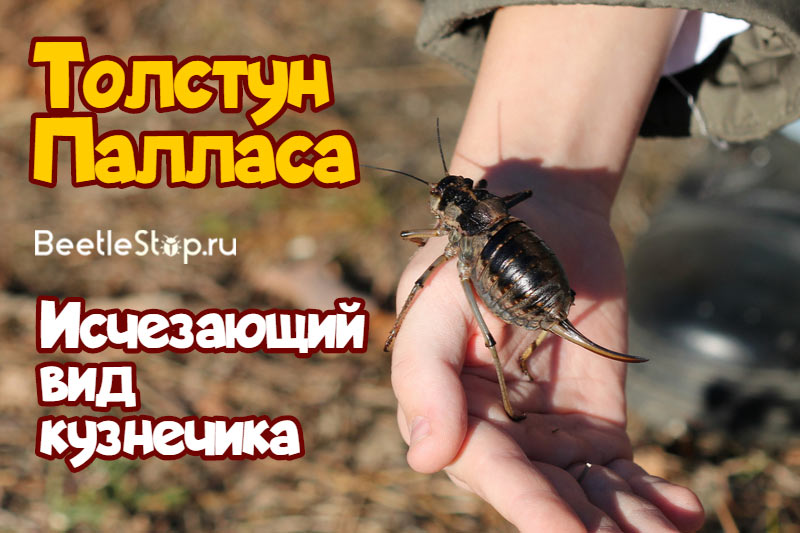Fat Pallas - a grasshopper who has forgotten how to jump
In nature, there are about 7 thousand species of grasshoppers living on all continents, excluding Antarctica. Most individuals have a slender long body and powerful hind limbs, adapted for jumping. But there are insects with a massive body and a round head, deprived of the ability to jump. These are globose-headed grasshoppers or chubs, a family that lives in the steppe regions of Eurasia. In Russia, the thicket Pallas lives - a large slow grasshopper. Insects do not have protective mechanisms, they are defenseless against any danger. Not surprisingly, their numbers are declining.

View description
The species of Pallas chunks (Deracanthaonos) belongs to the order Orthoptera, a family of globulose grasshoppers. The insect was first described by the German natural scientist P.S. Pallas in 1772. Synonyms of the name - pallas fat and heavy rumble. Representatives of the species have a massive body with a thick abdomen. The size of females is 47-57 mm, males - 40-50 mm. Females are superior to males in weight, by about 2 g. Coloring is motley.
There are two forms of pallas chunks - light and dark. In light type insects, the main color is sandy shades. Black spots are found on the pronotum and upper abdomen. In a dark-colored form, the body is green or gray, the pronotum is black with brown spots. Abdominal segments with wide black spots and brown spots. Transitional forms occur. Camouflage coloring, merging with the surrounding rare grass, is the only protection of the insect.
On pronotum two deep longitudinal grooves. The surface of the shield is rough. On the lateral keels of the female, tubercles may be present. The head is round, the top of the crown of the head is slightly isolated. Antennae are long, xiphoid, their base is located below eye level. The mouth apparatus is gnawing with powerful jaws.
Interesting fact. Rudimentary elytra impossible to notice in the normal state. Only during singing does the fat man raise the apron shield, under which the elytra are hidden. They are a sound device.
The fat man has 3 pairs of walking type legs. The hind limbs are longer than the front and middle. The outer thighs are spotty. Shins covered with spikes. The foot ends with two claws. The specific structure of the limbs does not allow grasshoppers of the Deracanthaonos species to jump or run fast. Legs are weak, easily damaged. At the top of the male’s abdomen there are cerci, appendages are the same in length and width. Females have a saber-shaped ovipositor of impressive size. Its length reaches 30-32 mm.
Habitat
The species of Pallas chubuns is considered to be Central Asian. The main distribution area is Northern Mongolia and Transbaikalia. Grasshopper is found in Tuva, Buryatia, the Far East, and China. The habitats are wormwood and feather grass and cereal steppes. Separate groups settle on stony sections of meadows, mountain slopes with low thickets.
Lifestyle
Adult grasshoppers appear in late July and are active until mid-September. According to the diet, thickwings belong to polyphages.Mostly feed on plant foods (cereals), but do not avoid the possibility of replenishing protein reserves on the remains of large insects. Captive grasshoppers eat vegetables and fruits.
Information. Cases of cannibalism are observed at home insectariums.
In the absence of the ability to jump and fly in case of danger, insects try to crawl into the shelter. If they are on a plant, then immediately fall or slide. Grasshoppers often settle in bushes of Karagan, where they find food and shelter. The favorite habitat of the species is the dry steppe with sparse vegetation and shrubs.
Breeding
Males are active during the breeding season. They creep considerable distances in search of a mating partner. The mating season lasts from August to early September. At this time, chirping spreads across the steppe. Not only males, but also females attract partners with sonorous trills. Fertilized females lay their eggs in the ground after 16 days. Their fertility is 60-100 pieces. The masonry remains to winter. Larvae appear in June-July of the following year. In the process of development, they molt 3-4 times.
Limiting factors and protective measures
Human economic activity associated with the steppe biotopes leads to a reduction in the number of pallas Pallas. Insects die as a result of fires, plowing of land, grazing, the use of chemicals in nearby fields. The endangered species is listed in the Red Book of Buryatia. To preserve grasshoppers, it is recommended that micro-reserves be created in the habitats of the Pallasian thicket.

